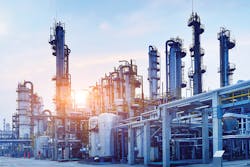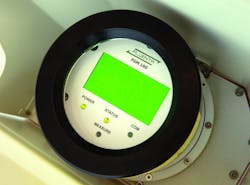The chemicals industry often relies on combining raw materials, under pressure and at heat, to create usable products. Central to our modern economy, the industry transforms materials such as oil, natural gas, air, water, metals and minerals, into more than 70,000 different products. The accurate measurement of fluids and gases, particularly under pressure, is an essential element to the safe creation of chemical solutions. Advanced technology can now help improve on-site safety, process efficiency and emissions reporting in the long run.
People first: On-site safety and security
Companies are responsible for the health and safety of their employees and any customers or suppliers visiting their premises, but delivering effective risk management is not easy in the chemicals industry. The penalties for failure and its impact on people, environment, reputation and revenue, however, are extreme. The chemical industry in the U.S. employs approximately 810,000 people and the nature of working with hazardous materials under significant pressure and heat exposes workers to potentially dangerous environments.
The energy industry is in discussions to use new visualization technologies such as virtual reality and augmented reality to train staff. Simulators, similar to those used in the airline industry, could expose workers to a range of hazards and scenarios that they may otherwise not be trained to react to. Mitigating risk in the chemicals industry and preparing personnel could be the difference between a well-managed chemicals production site and a large-scale disaster.
The U.S. Chemical Safety Board (CSB) has completed investigations into scores of accidents — including a number of chemical plant explosions — and has strongly suggested the use of smarter technology will help plants avoid similar events. Combined with an increased awareness of safety, technology is to be the driving force behind operational reform.
Ultrasonic measurement technology tolerates some condensed liquid, is not affected by gas composition and endures fluctuations in pressure and temperature. Courtesy of Fluenta
Connecting technology and separating risk
The sudden release of gas under pressure — or the introduction of an ignition source into an explosive or flammable environment — could cause a devastating explosion. Technology can now help the chemical industry more effectively sense, measure and monitor gas flow, providing the accurate information necessary to make more effective decisions.
Using new data analysis techniques, companies can be better informed around how chemical plants are running and make better — and faster — decisions across a range of chemical processes.
Monitoring equipment installed on local assets transmits information to software that is stored on central servers, rather than physically on-site. If an asset is malfunctioning — or is about to — chemicals companies will be alerted. Forty-five percent of oil and gas megaprojects suffer extended project shutdowns in their second year of production, according to data from Emerson Process Solutions. As large-scale, complex ventures that typically cost billions of dollars, megaprojects demand strict budget constraints and complete operational efficiency. Equipment failures and other process upsets could cause operators to miss production uptime and veer away from efficiency targets or cause an entire shutdown of a project, all which could cost millions in lost revenue.
Data driven
Cloud technology and the availability of internet connectivity now enables remote asset management to mitigate the risk of breakdown. Cloud infrastructure can support the constant monitoring and storage of data on remote servers anywhere in the world in real time via the Internet of Things (IoT). When real-time data is fed into software such as a continuous emission monitoring system (CEMS), organizations can then collect, record and report data remotely.
With internet connectivity available almost anywhere, businesses can access the CEMS data feeds of remote assets from multiple sites around the world. It is not necessary to store and run the software on a machine on-site, which removes the need for on-site staff and maintenance.
With continuous measurement, operators can discover leaks through a process called mass balancing. By accounting for material entering and leaving pipes, mass flows can be identified, which might have been unknown or previously difficult to measure. For example, operators can use mass balancing to identify faulty valves within their pipe systems that may be causing dangerous leaks. Remote action can be taken to update software, shut down failing or faulty systems, and if there is a danger of explosion, alert on-site personnel immediately.
Additionally, the data is stored securely on multiple remote servers with backup and is not dependent on the health and reliability of an on-site machine. Even if companies do not currently have technology to fully automate an installation, starting to collect relevant information now will enable more sophisticated decision-making for the future.
Risk and regulation
Regulatory compliance has also exacerbated operational and financial challenges. Processing and placing chemical products on the market requires extensive knowledge of global regulatory requirements. The chemicals industry is one of the most regulated industries, and its environment continues to grow more complex.
For example, the U.S. chemicals industry is regulated directly by legislation including the Toxic Substances Control Act (TSCA), the Chemical Facility Anti-Terrorism Standards (CFATS), the Federal Insecticide, Fungicide and Rodenticide Act (FIFRA), the Hazardous Substances Act and the Consumer Product Safety Act. In addition, all industries need to demonstrate continued compliance to legislation such as the Pollution Prevention Act (PPA) and TSCA import and export regulations.
These regulations place a burden on owners and operators to consistently audit existing facilities for compliance and execute comprehensive due diligence. The risk associated with noncompliance can be significant in terms of fines and fees.
A break in the supply chain
As an industry renowned for complex and volatile supply chains, disruption is another key risk for chemical sector companies. Longer supply chains create challenges for managing safety, on-time delivery, flexibility, responsiveness and sustainability. But the biggest danger for global supply chains is a sudden and severe break in the chain, which can be caused by a fire or explosion at a key supplier or a natural catastrophe. A break in supply chain could affect the sourcing and procurement of raw materials, conversion times and logistics. The fragility of global supply chains was highlighted in 2011 when an unusually large number of severe natural catastrophes severed supply chains for companies across the globe, such as the Tohoku earthquake and tsunami that shut down a number of chemical plants.
To reduce the likelihood of a broken supply chain, chemical plant operators should always consider the impact of an on-site accident or disaster in their management strategy.
Forward thinking with flaring
Flaring — the burning of excess natural gas — is a critical part of the oil and gas industry’s safety regime and can help companies maintain control over unpredictable process upsets. Flaring is often carried out at the startup and shutdown of chemical processing operations to prevent damage to equipment from volatile temperatures and rising pressures. The wealth of data collected by modern measurement meters for mass-balance calculation irregularities will even help identify potential leaks before they pose a risk to on-site safety.
Flaring is often carried out in the presence of high process temperatures (including hot gases) and involves a wide variety of compounds and gas compositions that create challenges for traditional measurement devices. One solution is to use ultrasonic technology — particularly suitable for fast, reliable flare gas measurement. The technology tolerates some condensed liquid, is not affected by gas composition and endures fluctuations in pressure and temperature. By deploying ultrasonic flare gas measurement, the oil and gas industry is better positioned to manage process upsets and prevent disruption, saving millions in potential lost revenue.
Sustaining success
Risk management is key for a safe and sustainable chemicals industry. A strong maintenance strategy, the implementation of connected technologies for improved plant oversight and more resilient personnel training all form the basis of a solid strategy. Risk control measures such as following recommended maintenance procedures could prove the difference between a safe working environment and a site fraught with danger. In addition to reducing fire risk by preventing overheating, regular maintenance will also help sustain a product’s supply chain. Combined, chemicals companies can proactively address past mistakes and implement solutions for a smarter, safer future.
Alex Keys is the global marketing director at Fluenta, a global leader in ultrasonic flow measurement for the oil and gas and chemicals industries. His extensive marketing experience, which covers both B2B and B2C, ranges from complex engineering equipment to medical device marketing.

